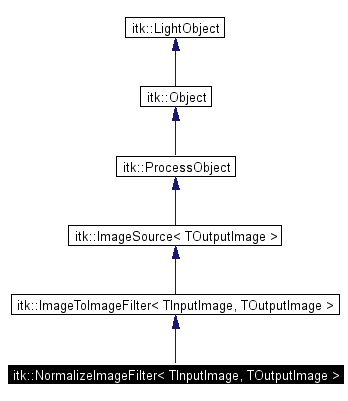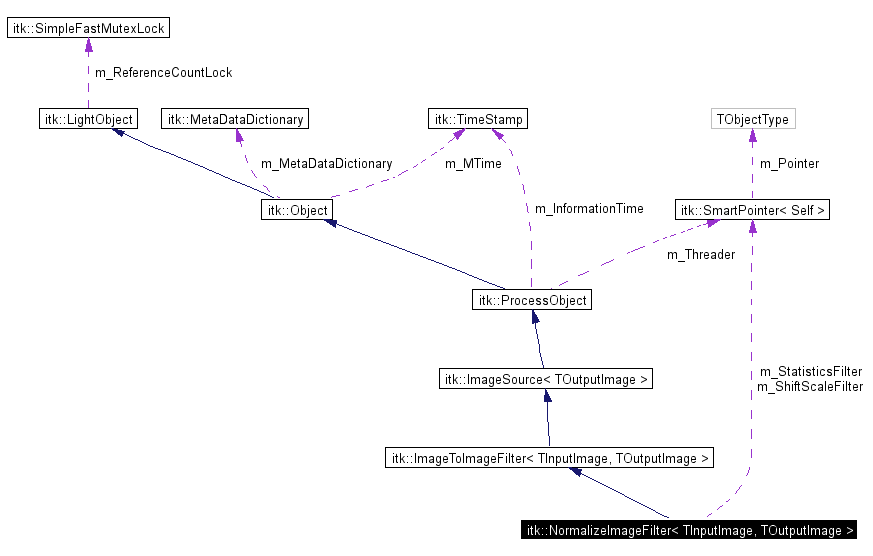
#include <itkNormalizeImageFilter.h>
Inheritance diagram for itk::NormalizeImageFilter< TInputImage, TOutputImage >:


Public Types | |
| typedef NormalizeImageFilter | Self |
| typedef ImageToImageFilter< TInputImage, TOutputImage > | Superclass |
| typedef SmartPointer< Self > | Pointer |
| typedef SmartPointer< const Self > | ConstPointer |
| typedef TInputImage::Pointer | InputImagePointer |
| typedef TOutputImage::Pointer | OutputImagePointer |
Public Member Functions | |
| virtual const char * | GetClassName () const |
Static Public Member Functions | |
| Pointer | New () |
Protected Member Functions | |
| NormalizeImageFilter () | |
| void | GenerateData () |
| void | GenerateInputRequestedRegion () |
NormalizeImageFilter shifts and scales an image so that the pixels in the image have a zero mean and unit variance. This filter uses StatisticsImageFilter to compute the mean and variance of the input and then applies ShiftScaleImageFilter to shift and scale the pixels.
NB: since this filter normalizes the data to lie within -1 to 1, integral types will produce an image that DOES NOT HAVE a unit variance.
Definition at line 41 of file itkNormalizeImageFilter.h.
|
|||||
|
Reimplemented from itk::ImageToImageFilter< TInputImage, TOutputImage >. Definition at line 49 of file itkNormalizeImageFilter.h. |
|
|||||
|
Image related typedefs. Reimplemented from itk::ImageToImageFilter< TInputImage, TOutputImage >. Definition at line 58 of file itkNormalizeImageFilter.h. |
|
|||||
|
Reimplemented from itk::ImageSource< TOutputImage >. Definition at line 59 of file itkNormalizeImageFilter.h. |
|
|||||
|
Reimplemented from itk::ImageToImageFilter< TInputImage, TOutputImage >. Definition at line 48 of file itkNormalizeImageFilter.h. |
|
|||||
|
Standard Self typedef Reimplemented from itk::ImageToImageFilter< TInputImage, TOutputImage >. Definition at line 46 of file itkNormalizeImageFilter.h. |
|
|||||
|
Reimplemented from itk::ImageToImageFilter< TInputImage, TOutputImage >. Definition at line 47 of file itkNormalizeImageFilter.h. |
|
|||||||||
|
|
|
|||||||||
|
GenerateData. Reimplemented from itk::ImageSource< TOutputImage >.
|
|
|||||||||
|
What is the input requested region that is required to produce the output requested region? The base assumption for image processing filters is that the input requested region can be set to match the output requested region. If a filter requires more input (for instance a filter that uses neighborhoods needs more input than output to avoid introducing artificial boundary conditions) or less input (for instance a magnify filter) will have to override this method. In doing so, it should call its superclass' implementation as its first step. Note that imaging filters operate differently than the classes to this point in the class hierachy. Up till now, the base assumption has been that the largest possible region will be requested of the input. This implementation of GenerateInputRequestedRegion() only processes the inputs that are a subclass of the ImageBase<InputImageDimension>. If an input is another type of DataObject (including an Image of a different dimension), they are skipped by this method. The subclasses of ImageToImageFilter are responsible for providing an implementation of GenerateInputRequestedRegion() when there are multiple inputs of different types.
Reimplemented from itk::ImageToImageFilter< TInputImage, TOutputImage >.
|
|
|||||||||
|
Runtime information support. Reimplemented from itk::ImageToImageFilter< TInputImage, TOutputImage >.
|
|
|||||||||
|
Method for creation through the object factory. Reimplemented from itk::Object.
|
 1.3.8 written by Dimitri van Heesch,
© 1997-2000
1.3.8 written by Dimitri van Heesch,
© 1997-2000